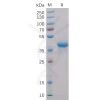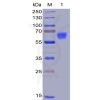| Target | |
|---|---|
| Synonyms | AMDM;ANPb;NPR2;ECDM;GC-B;GCB;GUC2B;GUCY2B;NPRB;NPRBi;SNSK |
| Description | Recombinant Human ANPRB Protein with C-terminal 6×His tag |
| Delivery | In Stock |
| Uniprot ID | P20594 |
| Expression Host | HEK293 |
| Tag | C-6×His Tag |
| Molecular Characterization | ANPRB(Arg23-Ile458) 6×His tag |
| Molecular Weight | The protein has a predicted molecular mass of 49.3 kDa after removal of the signal peptide. |
| Purity | The purity of the protein is greater than 85% as determined by SDS-PAGE and Coomassie blue staining. |
| Formulation & Reconstitution | Lyophilized from sterile PBS, pH 7.4. Normally 5 % – 8% trehalose is added as protectants before lyophilization. Please see Certificate of Analysis for specific instructions of reconstitution. |
| Storage & Shipping | Store at -20°C to -80°C for 12 months in lyophilized form. After reconstitution, if not intended for use within a month, aliquot and store at -80°C (Avoid repeated freezing and thawing). Lyophilized proteins are shipped at ambient temperature. |
| Background | This gene encodes natriuretic peptide receptor B, one of two integral membrane receptors for natriuretic peptides. Both NPR1 and NPR2 contain five functional domains: an extracellular ligand-binding domain, a single membrane-spanning region, and intracellularly a protein kinase homology domain, a helical hinge region involved in oligomerization, and a carboxyl-terminal guanylyl cyclase catalytic domain. The protein is the primary receptor for C-type natriuretic peptide (CNP), which upon ligand binding exhibits greatly increased guanylyl cyclase activity. Mutations in this gene are the cause of acromesomelic dysplasia Maroteaux type. [provided by RefSeq, Jul 2008] |
| Usage | Research use only |
| Conjugate | Unconjugated |
服务热线
400-006-0995
18062749453















